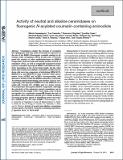Por favor, use este identificador para citar o enlazar a este item:
http://hdl.handle.net/10261/178238COMPARTIR / EXPORTAR:
 SHARE SHARE
 CORE
BASE CORE
BASE
|
|
| Visualizar otros formatos: MARC | Dublin Core | RDF | ORE | MODS | METS | DIDL | DATACITE | |

| Título: | Activity of neutral and alkaline ceramidases on fluorogenic N -acylated coumarin-containing aminodiols |
Autor: | Casasampere, Mireia CSIC ORCID; Camacho, Luz CSIC ORCID; Casas, Josefina CSIC ORCID ; Cingolani, Francesca CSIC; Egido-Gabás, Meritxell CSIC; Abad, José Luis CSIC ORCID ; Bedia, Carmen CSIC ORCID; Fabriàs, Gemma CSIC ORCID | Palabras clave: | Ceramides Sphingolipids Acid ciramidase |
Fecha de publicación: | 1-oct-2015 | Editor: | American Society for Biochemistry and Molecular Biology | Citación: | Journal of Lipid Research 56 (10): 2019-2028 (2015) | Resumen: | Ceramidases catalyze the cleavage of ceramides into sphingosine and fatty acids. Previously, we reported on the use of the RBM14 fluorogenic ceramide analogs to determine acidic ceramidase activity. In this work, we investigated the activity of other amidohydrolases on RBM14 compounds. Both bacterial and human purified neutral ceramidases (NCs), as well as ectopically expressed mouse neutral ceramidase hydrolyzed RBM14 with different selectivity, depending on the N -acyl chain length. On the other hand, microsomes from alkaline ceramidase (ACER)3 knockdown cells were less competent at hydrolyzing RBM14C12, RBM12C14, and RBM14C16 than controls, while microsomes from ACER2 and ACER3 overexpressing cells showed no activity toward the RBM14 substrates. Conversely, N -acylethanolamine-hydrolyzing acid amidase (NAAA) overexpressing cells hydrolyzed RBM14C14 and RBM14C16 at acidic pH. Overall, NC, ACER3, and, to a lesser extent, NAAA hydrolyze fluorogenic RBM14 compounds. Although the selectivity of the substrates toward ceramidases can be modulated by the length of the N -acyl chain, none of them was specific for a particular enzyme. Despite the lack of specificity, these substrates should prove useful in library screening programs aimed at identifying potent and selective inhibitors for NC and ACER3. Copyright © 2015 by the American Society for Biochemistry and Molecular Biology, Inc. | Versión del editor: | http://dx.doi.org/10.1194/jlr.D061564 | URI: | http://hdl.handle.net/10261/178238 | DOI: | 10.1194/jlr.D061564 |
| Aparece en las colecciones: | (IQAC) Artículos |
Ficheros en este ítem:
| Fichero | Descripción | Tamaño | Formato | |
|---|---|---|---|---|
| Activity of neutral and alkaline ceramidases on fluorogenic N -acylated coumarin-containing aminodiols.pdf | 1,73 MB | Adobe PDF |  Visualizar/Abrir |
CORE Recommender
PubMed Central
Citations
7
checked on 01-may-2024
SCOPUSTM
Citations
11
checked on 01-may-2024
WEB OF SCIENCETM
Citations
10
checked on 29-feb-2024
Page view(s)
285
checked on 06-may-2024
Download(s)
249
checked on 06-may-2024
Google ScholarTM
Check
Altmetric
Altmetric
Artículos relacionados:
NOTA: Los ítems de Digital.CSIC están protegidos por copyright, con todos los derechos reservados, a menos que se indique lo contrario.
